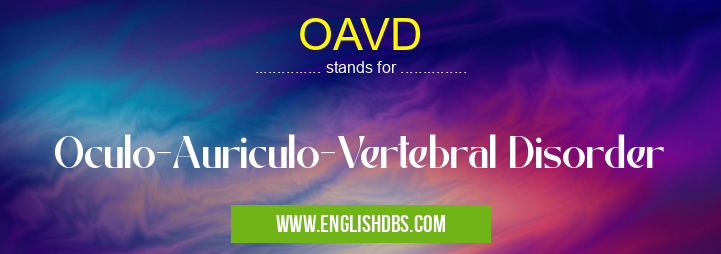What does OAVD mean in DISABILITY
Oculo-Auriculo-Vertebral Disorder (OAVD), also known as Goldenhar Syndrome, is an extremely rare congenital disorder characterized by craniofacial and related defects. It is caused by developmental abnormalities that occur in the upper portions of the spine, face and eyes. Affected individuals often experience facial asymmetry, small or absent ears, undescended eyes, and eye problems (such as strabismus, ptosis or cataracts). OAVD can also lead to physical impairments such as hearing loss, heart defects and/or limb malformations. Those affected should seek advice from a medical professional for appropriate treatment plans.

OAVD meaning in Disability in Medical
OAVD mostly used in an acronym Disability in Category Medical that means Oculo-Auriculo-Vertebral Disorder
Shorthand: OAVD,
Full Form: Oculo-Auriculo-Vertebral Disorder
For more information of "Oculo-Auriculo-Vertebral Disorder", see the section below.
» Medical » Disability
Definition
Oculo-Auriculo-Vertebral Disorder (OAVD) is a rare congenital disorder caused by developmental abnormalities in the upper portions of the spine, face and eyes. Common features include facial asymmetry, small or absent ears, undescended eyes, eye problems such as strabismus, ptosis or cataracts. Other associated physical impairments may include hearing loss, heart defects and/or limb malformations.
Causes
The cause of OAVD is still unknown but experts believe it may be due to multiple reasons including genetic mutations or environmental factors. Some cases appear to be hereditary suggesting a potential genetic relationship between certain individuals with OAVD; however more research needs to be done in this area before any conclusions can be drawn definitively.
Symptoms
The main symptoms of OAVD include facial asymmetry; abnormally small or missing ears; eye disorders (strabismus, ptosis or cataracts); hearing loss; heart defects; limb malformation; and other respiratory difficulties. Other symptoms such as vision disturbances have been reported as well but are not always observed in every case.
Treatment
Treatment for OAVD varies depending on the individual patient's symptoms and extent of their condition but generally includes surgical interventions to repair structural deformities; medications to control pain and inflammation; physical therapy to improve mobility; speech therapy to improve communication skills; hearing aids if needed; counseling support for emotional issues relating to the condition; and special education services if necessary.
Essential Questions and Answers on Oculo-Auriculo-Vertebral Disorder in "MEDICAL»DISABILITY"
What is Oculo-Auriculo-Vertebral Disorder?
Oculo-Auriculo-Vertebral Disorder (also called OAV disorder or Goldenhar Syndrome) is a condition characterized by underdevelopment of the face, jaw, and sides of the neck. It typically consists of a range of physical abnormalities that can include eye problems, hearing problems, cleft lip or palate and cardiac defects.
What causes OAV Disorder?
The exact causes are unknown, however it is believed to be the result of genetic and environmental factors.
Are there any associated medical conditions?
Yes. In addition to eye abnormalities, hearing loss and facial anomalies associated with OAV disorder, individuals may also experience other issues such as cleft lip or palate, scoliosis or spinal abnormalities, congenital heart defects and gastrointestinal issues.
Is it hereditary?
The condition can be inherited in some cases; however it is more commonly known to be caused by environmental factors during pregnancy.
Are there available treatments for this syndrome?
Yes. Treatment typically includes corrective surgery for facial deformities along with hearing aids and speech therapy if appropriate. Additionally there may be other treatments depending on associated medical conditions.
What kind of eye problems can occur as part of this syndrome?
Abnormalities caused by OAV disorder including microphthalmia (undersized eyes), coloboma (a hole in one or both irises), strabismus (misaligned eyes) and cataracts (clouding of the lens).
Is this condition life-threatening?
Generally no, however depending on associated medical conditions there may be issues that can potentially impact life expectancy.
What are the long term outlooks for individuals with this syndrome?
With proper treatment most individuals with OAV disorder lead active and healthy lives after managing their symptoms properly. Additionally many go on to lead successful careers and live full lives despite the physical implications from their diagnosis.
Does insurance cover costs associated with treatments for this disorder?
Most health insurance policies should cover diagnosis and treatment for an individual diagnosed with OAV disorder; however coverage will vary depending on your specific plan so it's best to contact your provider directly to confirm benefits before seeking care.
Final Words:
OAVD is an extremely rare disorder that affects many different parts of the body leading to facial deformities and other physical impairments such as heart defects, limb deficiencies, breathing problems etc. Although there is no cure yet available for this condition treatments like surgery help manage some of its symptoms while psychological support has been found beneficial in helping people cope with this challenging condition better over time.
